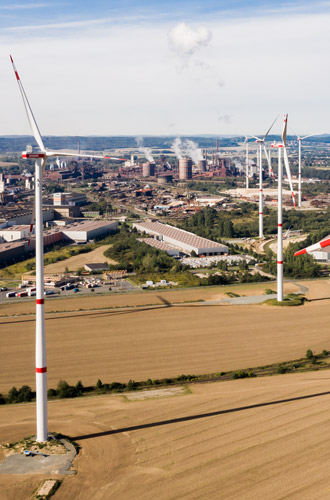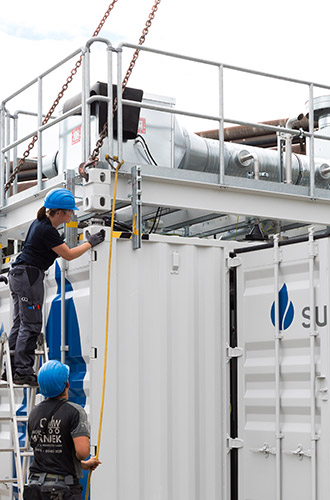“Windwasserstoff
Salzgitter”
“Salzgitter Hydrogen”
The aim of the “Salzgitter Hydrogen” sector-interconnection project is to generate hydrogen in Salzgitter through electrolysis and electricity from wind power. These activities are intended to put down the foundation for harnessing larger volumes of hydrogen in the future to reduce direct CO2 emissions in the production of steel. Avacon built seven wind turbines with an output of 30 megawatts on the premises of the Salzgitter Group, three of which are located on the grounds of the steel mill. Industrial gas supplier Linde ensures the steady supply of hydrogen. Within the context of this project, the partners are aiming to build up know-how for the environmentally compatible production of hydrogen, as well as for gaining experience with the on-site production of hydrogen and its incorporation into an integrated steel mill with its complex production processes.
Hydrogen delivered by Linde is already used today in the annealing processes that are part of producing steel. In addition, the use of hydrogen in mills opens up potential for significantly reducing the CO2 emissions generated from steel production processes in the future.
With a view to achieving this goal, Salzgitter AG conceived the SALCOS® (Salzgitter Low CO2 Steelmaking) project that maps a realistic path toward the gradual reduction of CO2 and, in the long term, steel production that is virtually free of CO2. As part of this project, hydrogen generated from renewable energies is to replace the carbon so far required for the smelting of iron ore.
Salzgitter Flachstahl is endeavoring to gain operational experience through this project in the area of generating “hydrogen from renewable energies” that is so important for SALCOS®. Subsequently, this experience could be drawn on for the implementation on an industrial scale. Although the framework conditions prevailing today do not permit the commercial operation of a direct combination of wind energy generation and electrolysis operations without government funding, the three partners are determined to develop and advance this technology that is so significant for the future and for climate protection.
Our future
The developer and operator of the park is Avacon Natur GmbH, a wholly-owned subsidiary of Avacon AG. The hubs of the turbines built by Vestas reach a height of 169 meters.
They will have an overall output of around 30 MW. The cost of the project as a whole – including the construction of the wind turbines and the hydrogen plant as well as the necessary infrastructure – amounts to around 50 million euro.
Salzgitter Flachstahl also built a PEM-Elektrolysis plant supplied by Siemens, to produce green hydrogen. The hydrogen can be used in the reduction of iron ore in place of the usual carbon. It therefore plays an important role in the “SALCOS – Salzgitter Low CO2 Steelmaking” concept and contributes to the goal of low-CO2 steel production.
Construction and operation of a PEM electrolysis plant
Under this project, SZFG will build and operate a PEM electrolyzer (PEM= Proton Exchange Membrane) with a capacity of 400 Nm³H₂/h and an installed output of around 2 MWel.
The PEM electrolyzer that is to be built in a central position on the site uses applied electrical voltage to break down water H₂O into hydrogen H₂ and oxygen O₂. The process requires ultra-pure distilled water made available on site through the purification of the industrial water obtained from SZFG’s own waterworks. Electricity is sourced from the plant’s own electricity grid. Hydrogen that is produced at a pressure of around 30 bar from electrolysis is fed into the existing hydrogen grid via a buffer storage. The extent to which the oxygen produced in parallel can be used will become clear over the course of the next project phase (plant tender), when the amount of the expenses incurred by provision and connection to the existing grid will be known.
Connecting wind power production and electrolysis operations
The planned seven wind power turbines (WPT) to be built and operated by Avacon Natur GmbH will be placed in the direct vicinity of the PEM electrolyzer. Direct connection would be technically possible without any great difficulty. The high load change rate of PEM facilities also lends itself to responding to volatile wind power production. The current legal position (German Renewable Energies Act (EEG), regulation on electricity feed-in to and consumption from electricity supply grids (StromNZV), etc.), also due to EEG levies on the electricity consumed and EEG feed-in subsidies not granted on excess volumes produced by wind power, prevent the commercially viable operation directly using wind power. The financial viability of the project has been ascertained on the basis of the current planning given that a subsidization of the project reduces the currently very high investment costs for PEM electrolyzers, and the supply of electricity can be made exempt of the EEG levy on own electricity generation.
Hydrogen requirement on SZFG’s plant premises
SZFG requires ultra-pure hydrogen for the inertization of the steel surfaces in the process of the bell annealing and hot-dip galvanizing lines. Around 4 million Nm³ are used here a year, distributed via SZFG’s own hydrogen grid with ca 10 bar to the consumers. SZFG currently sources this volume from Linde by trailer. The hydrogen depot built and operated by Linde is also to be used in the future to secure the volumes of hydrogen necessary for operations by continuing to cover any shortfall by trailer. Significantly larger, though qualitatively less sophisticated hydrogen volumes will be necessary for the future use of hydrogen as an iron ore reducing agent and as a substitute for carbon that is employed today.
Future-oriented projects

SALCOS® - Comprehensive concept for CO2 reduction
With SALCOS® (Salzgitter Low CO2 Steelmaking), together with partners from industry and research, we have laid the foundations for virtually CO2-free steel production. Central elements of the concept are electricity from renewable sources, green hydrogen and the use of direct reduction plants in which iron ore can be reduced CO2-free.

GrInHy - Green hydrogen through electrolysis
As part of the GrInHy 2.0 project, together with our partners Sunfire and Paul Wurth we built the world's most powerful high-temperature electrolyzer on our site. Using electricity from renewable energies and steam from waste heat from steel production, 200 Nm3 of green hydrogen per hour can be produced with high electrical efficiency.
Commissioning of WPTs and secure grid connection
Avacon AG is Germany’s largest distribution grid operator. The company reliably operates electricity and gas networks in the federal states of Saxony-Anhalt, Lower Saxony, Hesse and North Rhine-Westphalia. Avacon future proofs the networks and the tasks of tomorrow. More than € 160 million a year are earmarked for expanding the network and the integration of renewable energies. As a large scale regional supplier, Avacon plays an active part in implementing Germany’s renewable energy policy, with strong and innovative networks.
Avacon Natur GmbH is a wholly-owned subsidiary of Avacon AG. The company develops energy supply solutions based on renewable energies, as well as innovative and efficient technologies for industrial enterprises, commercial and domestic customers. Avacon Natur GmbH is the Avacon AG company entrusted with executing operations under this project.
Information on Avacon AG is available online at: www.avacon.de.
“If we want to secure a high share of green gas in our grids going forward, especially in the heat sector, we need a strong expansion of power-to-gas plants producing CO2-neutral hydrogen from renewable electricity through electrolysis. Against the backdrop of our large gas network infrastructure, Avacon considers it strategically important to gain the necessary expertise for the interconnection across sectors.”
Gaining and developing expertise in the production of hydrogen from renewable electricity and use in steel processing
Salzgitter AG ranks as one of Europe’s leading steel and technology groups, with external sales of around € 9 billion, more than 25,000 employees and just under 160 domestic and international subsidiaries and associates. The company is divided up into the business units of Steel Production, Steel Processing, Trading and Technology.
Salzgitter Flachstahl GmbH is its largest subsidiary, producing a wide range of high grade special and branded steels for sophisticated customer sectors such as the automotive industry.
Information on the Salzgitter Group is available online at: www.salzgitter-ag.com
“In the future, hydrogen will play a key role in mobility, the production and storage of energy, as well as in many other industrial processes. As we have demonstrated with our SALCOS® project, we command the technological wherewithal to achieve significant reductions in CO2 using hydrogen. We view the “Salzgitter Clean Hydrogen” project as a significant building block on our course to more environmentally compatible steel production.”
Supply reliability with H2 and incorporation of existing expertise
Linde plc is a leading industrial gas and engineering company with revenues (pro forma) of USD 28 billion (EUR 24 billion) in 2018. The company employs around 80,000 members of staff worldwide and serves customers in more than 100 countries across the globe. Linde plc delivers innovative and sustainable solutions for its customers and creates value added for all stakeholders.
The company makes our world more productive by developing products, technologies and services that improve the profitability and ecological performance of its customers in a networked world, while enabling them to lower their operating costs and enhance their efficiency.
Information on Linde plc can be found online at: www.linde.com
“We are greatly looking forward to our groundbreaking cooperation based on our long-standing and successful partnership. For more than a century, Linde has pioneered the use of hydrogen as an industrial gas in a wide range of applications. We have already gained positive experience in the future-oriented technology from the Mainz Energy Park. We will now be contributing this experience to the project in Salzgitter, which, together with our customers, will enable us to take another important step in the direction of an environmentally compatible supply."



































